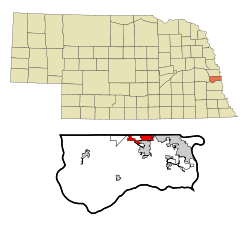Demographics
Historical population| Census | Pop. | Note | %± |
|---|
| 1970 | 4,858 | | — |
|---|
| 1980 | 9,588 | | 97.4% |
|---|
| 1990 | 9,840 | | 2.6% |
|---|
| 2000 | 11,699 | | 18.9% |
|---|
| 2010 | 15,758 | | 34.7% |
|---|
| 2020 | 16,746 | | 6.3% |
|---|
|
2020 census
The 2020 United States census [6] counted 16,746 people, 7,073 households, and 4,213 families in La Vista. The population density was 5,105.5 per square mile (1,972.4/km2). There were 7,314 housing units at an average density of 2,229.9 per square mile (861.5/km2). The racial makeup was 78.68% (13,176) white, 4.71% (788) black or African-American, 0.36% (61) Native American, 3.57% (598) Asian, 0.11% (19) Pacific Islander, 4.22% (706) from other races, and 8.35% (1,398) from two or more races. Hispanic or Latino of any race was 10.0% (1,858) of the population.
Of the 7,073 households, 26.0% had children under the age of 18; 44.5% were married couples living together; 29.3% had a female householder with no husband present. 29.4% of households consisted of individuals and 9.7% had someone living alone who was 65 years of age or older. The average household size was 2.4 and the average family size was 3.1.
24.0% of the population was under the age of 18, 8.8% from 18 to 24, 30.9% from 25 to 44, 24.7% from 45 to 64, and 13.6% who were 65 years of age or older. The median age was 35.3 years. For every 100 females, the population had 93.9 males. For every 100 females ages 18 and older, there were 91.1 males.
The 2016-2020 5-year American Community Survey [7] estimates show that the median household income was $70,184 (with a margin of error of +/- $4,275) and the median family income $84,777 (+/- $5,784). Males had a median income of $42,389 (+/- $3,203) versus $33,504 (+/- $3,262) for females. The median income for those above 16 years old was $38,068 (+/- $2,397). Approximately, 2.4% of families and 5.4% of the population were below the poverty line, including 5.4% of those under the age of 18 and 3.9% of those ages 65 or over.
2010 census
At the 2010 census there were 15,758 people, 6,419 households, and 4,058 families living in the city. The population density was 3,681.8 inhabitants per square mile (1,421.6/km2). There were 6,670 housing units at an average density of 1,558.4 per square mile (601.7/km2). The racial makeup of the city was 86.9% White, 3.9% African American, 0.4% Native American, 3.2% Asian, 0.1% Pacific Islander, 2.6% from other races, and 2.8% from two or more races. Hispanic or Latino of any race were 6.5%. [8]
Of the 6,419 households 34.5% had children under the age of 18 living with them, 45.7% were married couples living together, 12.9% had a female householder with no husband present, 4.6% had a male householder with no wife present, and 36.8% were non-families. 28.7% of households were one person and 5.1% were one person aged 65 or older. The average household size was 2.45 and the average family size was 3.06.
The median age was 32.1 years. 25.9% of residents were under the age of 18; 10.3% were between the ages of 18 and 24; 31.7% were from 25 to 44; 24.6% were from 45 to 64; and 7.5% were 65 or older. The gender makeup of the city was 48.3% male and 51.7% female.
2000 census
At the 2000 census, there were 11,699 people, 4,404 households, and 3,131 families living in the city. The population density was 4,114.8 inhabitants per square mile (1,588.7/km2). There were 4,511 housing units at an average density of 1,586.6 per square mile (612.6/km2). The racial makeup of the city was 90.45% White, 2.94% African American, 0.39% Native American, 2.35% Asian, 0.10% Pacific Islander, 1.62% from other races, and 2.14% from two or more races. Hispanic or Latino of any race were 4.15% of the population.
Of the 4,404 households 40.0% had children under the age of 18 living with them, 52.5% were married couples living together, 14.9% had a female householder with no husband present, and 28.9% were non-families. 21.4% of households were one person and 3.3% were one person aged 65 or older. The average household size was 2.66 and the average family size was 3.13.
The age distribution was 29.8% under the age of 18, 10.4% from 18 to 24, 36.4% from 25 to 44, 18.9% from 45 to 64, and 4.5% 65 or older. The median age was 30 years. For every 100 females, there were 94.6 males. For every 100 females age 18 and over, there were 89.6 males.
The median household income was $47,280, and the median family income was $52,819. Males had a median income of $34,732 versus $25,076 for females. The per capita income for the city was $19,612. About 4.4% of families and 5.7% of the population were below the poverty line, including 7.9% of those under age 18 and 3.1% of those age 65 or over.



